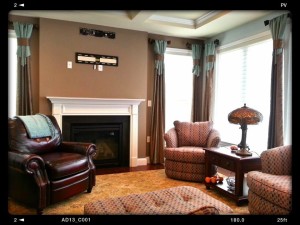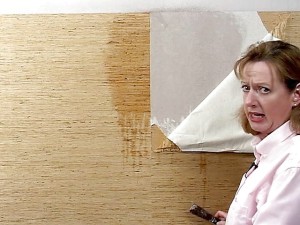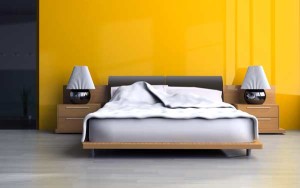
To Seal or Not to Seal Wallpaper…
Wallpaper has enjoyed great popularity over the years- and for good reason. It can be a beautiful wall covering, and when properly hung, will provide great durability and longevity. Because times change and personal tastes change along with them, however, this extended life span can be a curse, as well as a blessing. There are many reasons one may decide to move away from wallpaper- a fresh look, an out of style print, or it might literally be coming apart at the seams. Whatever the reason for the change, however, one thing is certain- a wallpaper adventure is about to begin! As a wise old painter, (ok, it was actually me,) once said, “Whoever invented wallpaper must not have been a painter.” Let’s take a look at the wild side of wallpaper– getting rid of it!
Wallpaper can be dealt with in one of two ways. First, the paper may be completely removed, and the surface repaired, re-primed, and repainted. This way is preferable IF the wallpaper was properly applied, because removing it will yield the most perfect final result. However, that “if” is a big word. Because there is no way to know if the paper was put on properly, (what adhesion material was used, was the wall board primed properly before application, etc… ) we sometimes find after starting the removal process that taking the paper off the wall causes too much damage to the wall beneath. This brings us to option number two- using a proprietary Just Add Paint technique of sealing wallpaper to the wall, and shaving / patching the seam areas in order to finish the job without damaging the underlying wall. While we always prefer to remove wallpaper when possible, this second technique also yields excellent results, and has the added advantage of taking less time and material, thus lowering the overall cost of the project.
Removing wallpaper is rocket science. This should not be true, but after hundreds of projects, we have never seen two that were exactly the same! We use a number of tools, materials, and techniques to remove wallpaper and get an excellent result- but the combination we chose is unique to each job, and sometimes even changes as we work. So if you ever hear us grumbling about changes while we work, fear not. Wallpaper removal is a process that evolves as we work- we always know WHAT we are doing, just not always “WHICH” we are doing until the action is well underway.
Steps to the Process
Wallpaper typically has three layers, each of which must be removed completely for the best possible result. Layer 3 is the glue which binds the paper to the wall. Layer 2 is the backing paper, and layer 1, the outer layer, is the layer visible to us on the walls.
Layer 1, the outer layer, must be removed 1st. This may be done in several ways, but all involve wetting the outer layer in order to allow it to be peeled off in sheets, rather than tiny pieces. We find this is often done most easily with a steamer- a unit used to apply water and some paper softening chemical to the all surface. This step is time consuming, but if done properly, makes the rest of the job go smoothly!
Layer 2, the backing paper, may be accessed once layer 1 is removed. This paper may also be steamed for removal, or simply wet down with a solution of hot water and fabric softener. Again, in an ideal situation, the backing paper will come off in sheets, and may even bring much of the glue, (layer 3,) with it. However, this depends greatly on how well the paper was put up in the first place. For this example, let’s assume that this layer releases for us and comes down cleanly.
Layer 3, the glue, is where the muscle work comes into play. We continue to wet the wall using the hot water / paper removal mix. We use razor sharp scrapers to slide along the wall, in an attempt to remove this glue without damaging the underlying wall. This involves carefully monitoring the amount of moisture we place on the wall, and the amount of chemical we mix into the water. This is the layer that makes all the difference. If the wall was primed before the paper was put up, in many cases the glue will scrape right off, with no damage to the underlying wall. This is a best case scenario, but RARELY happens.
If the paper was applied to bare drywall or a wall that was not, in some other way, prepared before glue was applied, this is where the wall damage can take place. (Unfortunately when glue binds directly to the drywall, it will often tear apart the front of the drywall, leading to an ugly mess that requires a huge amount of priming, sanding, and patching to repair.) If all goes well with layer 3 and the glue comes off cleanly, all that is left is to make sure the wall is dry, sand away any remnants of glue, then apply oil-based primer, or shellac, an alcohol based primer, to the wall. (This guarantees that no glue residue will ever be visible on the completed wall.) After this, patching and painting will finish the job, with a beautiful result!
What if things DON’T go smoothly?
This is where things get a bit more interesting, because things almost NEVER go 100% smoothly with wallpaper! While we prefer to remove wallpaper for the best possible result, we often find that we can create a beautiful result by binding the paper to the wall, rather than pulling it down.
Sealing wallpaper is a technique that can be used in two cases. Either the budget does not allow for the time required to properly remove all of the wallpaper, OR improper installation of the paper results in a situation where damage to the walls outweighs the improvement in the final product warranted by removal. In either of these cases, we recommend shellac priming the paper to the wall, then shaving, patching, priming, and sanding the wall in such a way that the old paper is nearly invisible. Although no previously papered surface is ever as perfect as finished bare drywall, we have found that our results with this process often yield a product where the existing paper, still on the wall, would not be visible to the untrained eye.
For More on Wallpaper removal: https://www.justaddpaint.net/ultimate-wallpaper-extravaganza-add-paint
This things can make your painter look bad, but it’s not their fault! https://www.justaddpaint.net/things-that-make-your-painter-look-bad
Please like and follow our facebook page at www.facebook.com/justaddpaint




